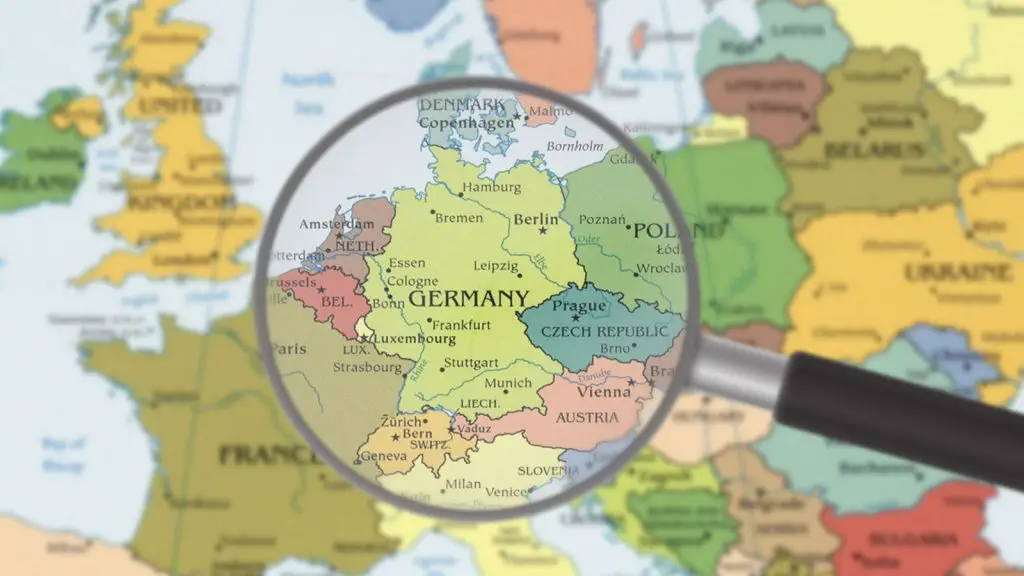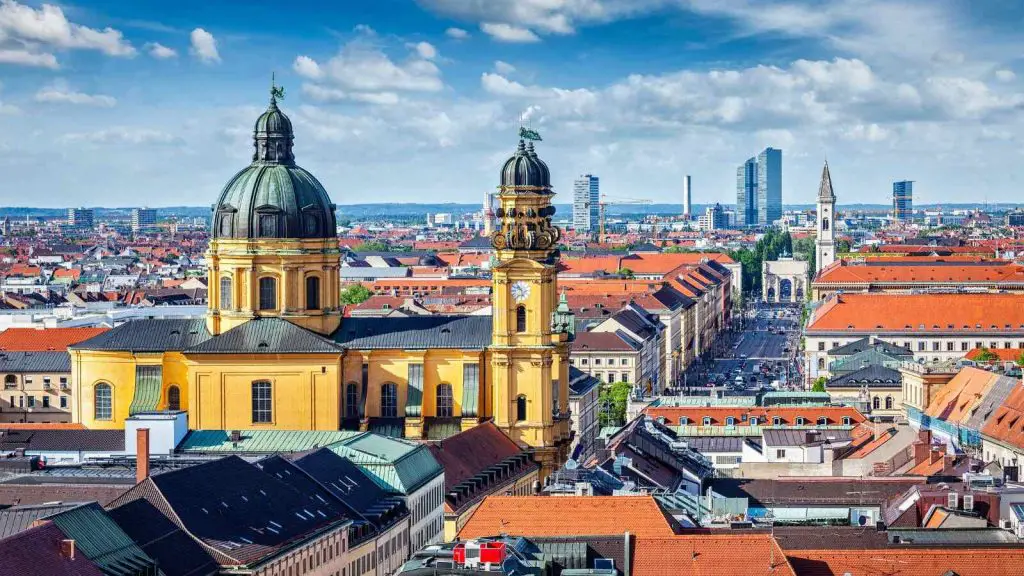Germany is often thought of as a large country, but when compared to the United States, the size of Germany is actually quite small. This is due to the fact that Germany has a much higher population density than the United States.
As a result, Germany’s land area per person is only about a quarter of the size of the United States. Despite its small size, Germany is a major economic powerhouse and is home to some of the world’s largest companies.
The geographic size of Germany
Germany covers an area of 357,114 square kilometers. This makes it the 61st largest country in the world in terms of landmass. It is slightly smaller than Myanmar and slightly larger than Ghana.
In terms of population, Germany is the most populous country in Europe, with an estimated 82 million people. This means that it has a population density of 232 people per square kilometer.
The largest German state by population is North Rhine-Westphalia which is home to over 18 million people. The smallest state is Bremen which has a population of just over 680,000 people.
What is the size of Germany in square miles?

Germany is a Central European country extending from the Alps across the North European Plain to the North and Baltic Seas.
Germany shares borders with nine other countries: Denmark, Poland, the Czech Republic, Austria, Switzerland, France, Luxembourg, Belgium and the Netherlands.
With an area of 357,114 square kilometers (about137,843 square miles), Germany is slightly smaller than Montana in the United States. Bavaria is Germany’s largest state, with an area of 70,549 square kilometers (27,200 square miles).
What is the nicest German city?
Munich is a beautiful city with a rich history and culture. It is also very clean and well-organized, with plenty of green space for residents and visitors to enjoy. The people of Munich are friendly and welcoming, making it a great place to visit or live.
What is the best German state to live in?
If you want a big city with plenty of job opportunities, then you should move to Berlin. If you want a smaller city with a more laid-back lifestyle, then try Munich or Hamburg.
If you are looking for a state with a lot of natural beauty, then Bavaria is the place for you. And if you want to experience a truly unique culture, then head to Saxony-Anhalt in eastern Germany.
What city in Germany has the most foreigners?
The answer is Munich. In 1900, nearly 30% of the city’s population was foreign-born. This was due to the city’s large number of jobs in manufacturing and its status as a major cultural center.
Munich’s foreign population came from all over Europe, including Poland, Russia, Austria-Hungary, and Italy. Many of these immigrants were attracted by the city’s growing economy and its tolerant attitude towards different cultures.
Where do most American live in Germany?
Although Germany is about the same size as Texas, it has a much smaller population. Most German people live in small towns and villages.
The largest city in Germany is Berlin, but only about one-fifth of the German people live there. The rest of the German people live in the countryside or in small towns and villages.
What is the safest city in Germany?

Based on various measures of safety, including crime rates, traffic safety, and environmental hazards, these three cities are generally considered to be the safest in Germany: Munich, Frankfurt, and Hamburg.
What is the cleanest city in Germany?
Bavaria is the largest state in Germany, and it’s also home to some of the country’s cleanest cities. Despite its large size, Bavaria has a relatively low population density.
This means that there’s more space for parks and green spaces, which helps keep the air and water clean. The state also has strict environmental laws that help to keep pollution down.
Which German city is the richest?
In terms of GDP per capita, the richest city in Germany is Munich. The city has a GDP per capita of €78,632, which is more than double the national average. Munich is also the largest city in Germany, with a population of over 1.3 million.
Is it cheaper to live in Germany or USA?
The cost of living in Germany is generally lower than in the United States, although there are exceptions. For example, housing costs in Germany are often higher than in the US, while transportation costs are usually lower.
The cost of living also varies depending on the size of the city you live in. In general, larger cities like Berlin and Munich are more expensive than smaller cities like Dresden or Leipzig.
Overall, the cost of living in Germany is about 10-15% cheaper than in the US.
What’s a good salary in Germany?
Generally speaking, though, a good salary in Germany is one that falls somewhere between 3500 and 4000 euros per month after taxes.
With this kind of income, you should be able to cover your basic expenses without too much difficulty and still have some money left over for other things.
Is Germany the size of Texas?

Germany is about the same size as Texas. With an area of 357,022 square kilometers, Germany is about the same size as Texas, which has an area of 268,581 square kilometers.
Germany is slightly larger than France (341,543 square kilometers) and slightly smaller than Spain (505,370 square kilometers).
What US state is the size of Germany?
Germany is about the same size as the US state of Texas. Bavaria, Germany’s largest state, is about the size of Maine. So when you’re thinking about the size of Germany, think big!
But also keep in mind that Germany is a very densely populated country, with more than 82 million people living in an area smaller than Oregon.
Is Germany small or big?
Germany is a large country with a population of over 80 million people. It covers an area of 357,022 square kilometers, making it the 62nd largest country in the world.
Germany is about the same size as Texas, which has a population of around 28 million people.
Is Japan or Germany Bigger?
In size comparison, Germany is bigger than Japan. Germany has an area of 357,022 square kilometers, while Japan has an area of 377,915 square kilometers.
When it comes to population, however, Japan is more populous than Germany. As of 2016, the population of Japan was estimated at 127 million people, while the population of Germany was estimated at 82 million people.
How long does it take to drive across Germany?
The journey across Germany can be broken up into a few different legs. The first leg would be from the northwestern city of Hamburg to Frankfurt am Main in the south.
This section of the trip would take about six hours to complete. The second leg would be from Frankfurt am Main to Munich in the southeast. This section would take about four hours to complete.
The final leg would be from Munich back up to Hamburg in the north. This final section would take about five hours to complete.
Is England bigger than Germany?

No, England is not bigger than Germany. In fact, Germany is about the same size as Texas. Both countries are about 350,000 square kilometers. So why do so many people think that England is bigger than Germany?
One reason may be that England has a lot of coastlines. With its islands, England has about 12,429 kilometers of coastline. That’s almost three times more than the German coastline of 4,750 kilometers.
Which state has the most German population?
Texas is often thought of as a “melting pot” of sorts, and its German population is no exception. With over 4 million Germans living in the state, Texas easily tops the list.
California, Florida, and Illinois round out the top five states with the most German residents.
Is driving in Germany difficult?
No, driving in Germany is not difficult. The country is about the size of Texas, so it’s a manageable size to get around. Plus, the Autobahn makes it easy to travel between cities.
What is the most German city in America?
According to a recent study, the most German city in America is actually New Braunfels, Texas.
While the city’s population is only about 62,000, that’s still more than double the size of Bavaria, Germany’s largest state. And when it comes to the percentage of Germans in the population, New Braunfels beats out all other American cities.
Almost 40% of its residents are of German descent.
What is the size of Germany compared to Texas?
Germany is about the same size as Texas. Germany is slightly smaller than Texas, with an area of 357,022 square kilometers compared to Texas’s 695,662 square kilometers.
Germany is located in Central Europe and borders 9 other countries. The country has a population of over 82 million people.
If you want to know more about our details post about how big is Texas as compared to Europe, read it, and you will learn some new facts. Try it to learn something amazing and interesting about Texas and Europe.
What is the size of Germany compared to UK?

The United Kingdom has a land area of 243,610 square kilometers, while Germany has a land area of 357,022 square kilometers.
This means that Germany is about 46% larger than the United Kingdom in terms of land area. But, when we compare the population sizes of these two countries, we see a different story.
The United Kingdom has a population of about 66 million, while Germany has a population of about 82 million.
What is the size of Germany compared to Australia?
Germany is about the same size as Montana, while Australia is about the same size as the contiguous United States. Germany has an area of 357,386 square kilometers, while Australia has an area of 7,682,300 square kilometers.
This means that Australia is about 21 times larger than Germany.
What is the size of Germany compared to Canada?
Germany is about the same size as Alberta. Canada is about nine times larger than Germany. If you put Germany in the middle of Canada, it would reach from Thunder Bay to just north of Saskatoon.
If you put Canada in the middle of Europe, it would stretch from Portugal to Russia and from Norway to Italy.
What is the size of Germany compared to California?
Germany is a little over one-fifth the size of the United States, while California is about one-eighth the size of the United States. So when you compare the two states, Germany is actually slightly larger than California.



